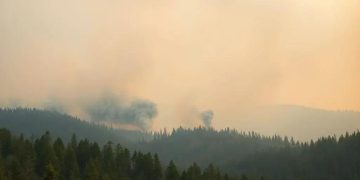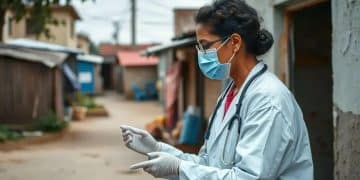Heat-related emergency room visit trends you should know

Heat-related emergency room visit trends indicate an alarming rise in heat-related illnesses, particularly among vulnerable populations such as the elderly, children, and those with chronic conditions, requiring effective preventive measures to safeguard public health.
Heat-related emergency room visit trends are on the rise, raising concerns for public health. Have you noticed how the soaring temperatures might be impacting your community? Let’s dive deeper into this issue and explore the implications.
Understanding heat-related illnesses
Understanding heat-related illnesses is crucial as warmer temperatures become more common. These conditions can escalate quickly, so being informed is essential. When the body overheats, it can lead to serious health issues.
Types of heat-related illnesses
There are several types of conditions to be aware of:
- Heat exhaustion: This occurs when the body loses too much water and salt, often due to prolonged exposure to high temperatures.
- Heat stroke: A more severe condition, heat stroke happens when the body’s temperature regulation fails, causing body temperatures to soar to dangerous levels.
- Heat cramps: These painful muscle spasms can occur during vigorous exercise in high temperatures, often related to electrolyte loss.
Recognizing the symptoms early can make a significant difference. Indicators of heat-related illnesses include excessive sweating, weakness, and confusion. Many people may not realize how quickly these symptoms can develop, especially during hot weather.
Who is at risk?
Understanding who might be at risk is important for prevention. The following groups are particularly vulnerable:
- Children and infants
- Older adults, especially those with pre-existing health conditions
- People with certain medical conditions, such as heart disease
These individuals should take extra precautions when temperatures rise. It’s essential to stay hydrated and seek shade or cool environments when possible. By understanding heat-related illnesses, we can better protect ourselves and others during the summer months.
Trends in emergency room visits due to heat
Trends in emergency room visits due to heat highlight how rising temperatures impact public health. These visits often spike during heatwaves, revealing alarming patterns of increasing heat-related incidents.
Rising statistics
Data over the past decade shows a steady increase in the number of heat-related visits. Many cities experience dramatic surges during summer months. This trend is concerning, especially in areas not typically used to extreme heat.
- Increased visits are particularly noted in urban areas where heat is trapped.
- Vulnerable populations, such as the elderly and children, show higher rates of hospitalization.
- Many patients exhibit severe symptoms requiring immediate care, such as dehydration and confusion.
Monitoring these trends helps healthcare providers prepare for peaks in demand. By understanding who is affected, the medical community can take proactive measures to protect those at risk. For instance, hospitals may implement cooling stations during peak heat periods.
Factors influencing ER visits
Several factors contribute to the increase in emergency room visits related to heat. Climate change plays a significant role. As temperatures continue to rise, heatwaves are becoming more frequent and intense.
Additionally, urbanization impacts how heat is experienced. Busy cities, with their concrete and asphalt, often face higher temperatures than surrounding rural areas. Thus, monitoring heat trends becomes vital for effective public health responses. If these trends continue, the healthcare system will face more challenges in managing heat-related emergencies.
At-risk populations for heat-related emergencies

Identifying at-risk populations for heat-related emergencies is essential to prevent serious health issues. Certain groups are more vulnerable to the effects of extreme heat, making awareness and preparation crucial.
Children and infants
Young children, especially infants, are at a higher risk. Their bodies can’t regulate temperature as effectively as adults. They can easily become overheated during hot weather. Parents and caregivers should ensure that children stay hydrated and cool.
Older adults
Older adults also face significant risks. As people age, their bodies become less efficient at regulating temperature. Many older individuals have health conditions that further increase their risk. This group may need special attention during heat waves.
- Health problems like heart disease can exacerbate heat-related issues.
- Limited mobility may hinder access to cooling areas.
- Medicines can affect how the body deals with heat.
What’s more, social isolation can leave elderly people with fewer resources for protection against heat. It’s important to check in on elderly neighbors or relatives during hot days.
Individuals with chronic illnesses
People with chronic illnesses, such as respiratory or cardiovascular diseases, are also more susceptible. Their bodies may react differently to heat, putting them at greater risk for complications. Monitoring health conditions during high temperatures is crucial for these individuals.
Additionally, those with mental health conditions may not respond well to heat, as high temperatures can worsen anxiety and other symptoms. Understanding these vulnerabilities can lead to better responses during heat waves. Communities can implement programs to help protect these at-risk populations.
The impact of climate change on health
The impact of climate change on health is a pressing issue we must address. Rising temperatures, changing weather patterns, and extreme events can lead to various health complications.
Increased heat-related illnesses
One major effect of climate change is the rise in heat-related illnesses. As temperatures soar, more individuals face risks like heat exhaustion and heat stroke. This is especially concerning for vulnerable populations, such as the elderly and children.
- More frequent heatwaves can overwhelm our health systems.
- Prolonged exposure to high temperatures heightens the risk of dehydration.
- Increased cases of heat-related hospitalizations are reported during peak summer months.
These trends highlight the urgent need for adaptive health strategies. Public awareness campaigns can educate communities about recognizing symptoms and staying safe during extreme heat.
Air quality and respiratory issues
Climate change also affects air quality. Rising temperatures contribute to the formation of ground-level ozone, which can worsen respiratory problems. For individuals with asthma or other lung conditions, this poses significant health challenges.
Additionally, increased wildfires linked to climate change can further deteriorate air quality. Smoke from these fires can lead to respiratory issues even for those without pre-existing conditions.
Water and food security
Water supply and food security are also at risk. Climate change can lead to droughts, affecting crop yields and food availability. As access to clean water becomes limited, the risk of waterborne diseases increases. These impacts can lead to malnutrition and other health issues.
Understanding how climate change influences these aspects of health helps communities plan and respond effectively. More research is necessary to address these challenges and protect public health as climates continue to evolve.
Preventive measures and tips for hot weather
Taking preventive measures in hot weather is essential to protect your health. Implementing simple tips can help you stay safe and comfortable during extreme heat.
Staying hydrated
One of the most important tips is to drink plenty of water. Staying hydrated helps regulate body temperature and prevents heat-related illnesses.
- Carry a water bottle with you.
- Avoid alcohol and caffeine, as they can lead to dehydration.
- Drink water before, during, and after being outside.
Pay attention to your body’s signals. If you feel thirsty, dizzy, or fatigued, take a break and rehydrate.
Finding shade and cooling areas
When the sun is blazing, seek shade whenever possible. Staying in a cool environment can lower your risk of overheating.
Here are some options:
- Visit air-conditioned places like shopping malls or libraries.
- Use umbrellas or hats to block the sun while outside.
- Limit outdoor activities during the hottest parts of the day, typically from noon to 4 p.m.
These strategies are especially important for vulnerable populations, such as children and the elderly.
Wearing appropriate clothing
The clothing you choose can make a big difference in hot weather. Lightweight and loose-fitting clothes allow for better air circulation.
Consider wearing:
- Light-colored fabrics that reflect sunlight.
- Cotton or linen materials that breathe well.
- A wide-brimmed hat for extra sun protection.
Following these tips can help everyone stay safe in the heat. Preventive measures are key to enjoying warm weather without adverse health effects.
FAQ – Frequently Asked Questions about Heat-Related Emergencies
What are heat-related illnesses?
Heat-related illnesses are health conditions that occur due to prolonged exposure to high temperatures. Common types include heat exhaustion and heat stroke.
How can I prevent heat-related illnesses during hot weather?
Stay hydrated, seek shade, wear light clothing, and limit outdoor activities during the hottest parts of the day to prevent heat-related illnesses.
Who is most at risk for heat-related emergencies?
Vulnerable populations, including children, the elderly, and individuals with chronic illnesses, are most at risk for heat-related emergencies.
What should I do if someone shows signs of heat exhaustion?
Move the person to a cooler area, provide water, and apply cool cloths to their skin. If symptoms persist or worsen, seek medical help immediately.





